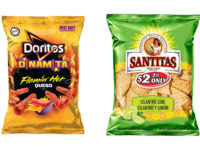Manufacturers of tortilla and tostada chips continue to expand the boundaries of their offerings, in terms of both more imaginative flavors and attempts to address consumer concerns about the healthfulness of a category traditionally known for corn, salt and carbs.
Overview | Chips | Puffed/Extruded Snacks | Popcorn | Snack Mixes & Nuts | Tortilla Chips | Pretzels | Frozen Snacks | Crackers
Sales in the category maintain steady growth still dominated by traditional brands that date back decades, although the fastest growth comes from two camps: brands touting their “better for you” attributes and those with an unbridled passion for bold flavor.
Market data
The subcategory of tortilla/tostada chips grew a steady 2.85 percent to $5.06 billion in sales during the 52 weeks ending April 16, 2017 according to IRI, Chicago.
The top-grossing company in tortilla/tostada chips—by a wide margin—remains Frito-Lay, which commandeered 72.81 percent market share with $3.6 billion in sales across its tortilla/tostada brands, up 1.75 percent from a year earlier. Barcel USA was a distant second with $283.3 million in sales, although their dollar sales grew an impressive 37.19 percent. Private label tortilla/tostada chips in the aggregate finished slightly behind Barcel, at $281.9 million, up 9.55 percent.
Iconic Frito-Lay brand Doritos dominates the segment, up 3.59 percent to $2.1 billion, with 41.34 percent market share. Frito-Lay also takes the next two top brands: Tostitos, down 0.95 percent to $639.9 million; and Tostitos Scoops, up 0.79 percent to $470.9 million.
The fastest-growing brands were Late July, up 77.76 percent to $23.94 million. Late July, an organic chip producer, is part of the Snyder’s-Lance better-for-you snack division, Clearview Foods. Tostitos Simply, a clean-label line from Frito-Lay, was up 46.86 percent to $37.0 million. And on the bold front, Takis Fuego spicy chili-lime rolled tortilla chips from Barcel, a business unit of Grupo Bimbo, climbed 38.79 to $255.36 million.
Looking back
Tortilla and tostada chip brands have released a number of offerings during the past year aimed at enticing consumers with varying combinations of convenience, new flavors and answers to their concerns about healthfulness.
In September 2016, Frito-Lay’s Tostitos brand introduced a new offering: Hint of Jalapeño, which has a mild jalapeño flavor with notes of onion and garlic. The packaging includes a jalapeño-shaped window to highlight the new flavor.
Earlier this year, Truco Enterprises announced two new flavors of its On the Border tortilla chip brand: Nacho Cheese and Zesty Ranch. The company saw dollar sales growth of 17.02 percent for its On the Border chips for the year, up to $182.4 million, per IRI.
In January, Hain Celestial introduced two new offerings of its Garden of Eatin’ brand: Ranch and Nacho. The Nacho variety offers creamy farmhouse Cheddar and paprika flavors, while Ranch has hints of buttermilk, garlic and onion flavors. Both are certified organic, non-GMO, gluten-free, certified kosher and contain 25 percent less fat than leading conventional competitors, the company says.
Siete Family Foods released three new varieties of its grain-free tortilla chips in December 2016: Sea Salt, Nacho and Lime. Available at Whole Foods Market, the chips are made with cassava flour and avocado oil, and they are non-GMO, gluten-free, and contain no corn, wheat, rice, beans, soy or dairy.
In September 2016, Buck Wild introduced two new flavors of its natural tortilla chips: Cheddar Chipotle and Garlic Sea Salt. Available at Walmart, these new gluten-free offerings are made with no artificial flavors or preservatives.
Another launch leaning toward better-for-you came from Good Health Snacks. The Organic Black Bean & Rice chips represent the snack producer’s first foray into the tortilla chips segment. The chips are made with broccoli, beets, tomatoes, spinach, carrots, brown rice flour and black beans, topped with Himalayan salt. The chips are free of hydrogenated oils, preservatives, trans fat and artificial colors.
Looking forward
In the next year, trends toward more exotic flavors, as well as more natural and organic offerings, will continue.
“Healthier and better-for-you inclusions are a key trend within the snack and tortilla chip category,” says Ricardo Rodriguez, marketing manager for confectionary & bakery, Ingredion, Inc., Bridgewater, N.J. “Developers are looking for new and unique ingredients that can help them create healthier products, while either maintaining a specific texture or creating a new one.”
Injecting fiber and protein into low-moisture snacks remains a challenge, which is why savory snack makers are turning to vegetables and pulse-based ingredients like peas, lentils, fava beans and chickpeas, Rodriguez says.
“Pulses add the nutrition benefits of protein and fiber that address consumer needs for protein- and fiber-rich, clean-label products,” says Rodriguez. “They can boost the nutritional profile of formulations, replace allergens and also help support popular label claims such as non-GMO, vegan and gluten-free.”
Consumer demands for label-friendly, healthful ingredients are driving most of the innovation in snack food, including tortilla chips, says Chad Rieschl, senior research technologist at Cargill, Minneapolis. “Consumers want to recognize the ingredients in their snacks and know where those ingredients come from,” he says. “A growing number of consumers not only want to know what is in a product, but also how those ingredients are made.”
Beyond clean labels, consumers also want baked rather than fried products, as well as reduced sugar, Rieschl says. Ingredients like corn bran can boost fiber, while whole-grain corn provides one avenue to make claims around whole-grain levels, he says.
Combining a number of grains, including corn, rice, wheat and others, with high levels of protein and fiber, builds an appealing profile, Rieschl says. “Plus, they offer the flexibility to create unique flavors and textures that reflect current consumer trends,” he adds, noting that taste remains consumers’ highest priority.
Intense flavors continue to dominate consumer desires, says Carol Lowry, food scientist, Cargill. “Consumers are looking for new flavor combinations that are more complex, bold and spicy,” she says. “Global flavors and ethnic products are a hit, especially with the millennial generation. Millennials aren’t just eating more snacks; they consume them around the clock, opting for snacks for breakfast, lunch and dinner.”
Overview | Chips | Puffed/Extruded Snacks | Popcorn | Snack Mixes & Nuts | Tortilla Chips | Pretzels | Frozen Snacks | Crackers















